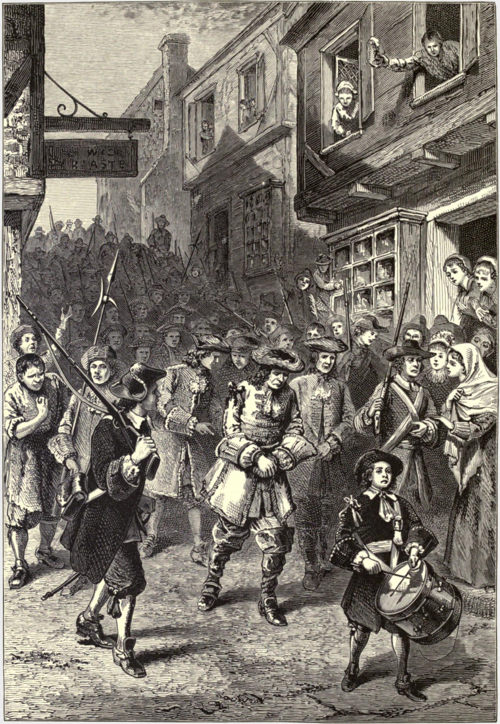The 1689 Boston Revolt
The 1689 Boston revolt was a significant uprising that took place on April 18, 1689, against the rule of Sir Edmund Andros, the governor of the Dominion of New England. A well-coordinated group of provincial militia and citizens formed in Boston, the capital of the dominion, arresting officials associated with the dominion. Those identified as members of the Church of England who were perceived as supporters of the dominion were also detained. Neither side experienced any casualties during the revolt. Following the uprising, leaders from the former Massachusetts Bay Colony regained control of the government, and in other colonies, displaced governments were reinstated.
Background
In the early 1680s, King Charles II of England sought to centralize the administration of the American colonies to tighten crown control. He revoked the charter of the Massachusetts Bay Colony in 1684 after its leadership refused to comply with his reform demands. Following the king’s death in 1685, his successor, James II, continued these efforts, leading to the establishment of the Dominion of New England. Andros, the former governor of New York, was appointed as the dominion governor in 1686. The dominion included territories from Massachusetts Bay, Plymouth Colony, Connecticut Colony, the Province of New Hampshire, and the Colony of Rhode Island and Providence Plantations, later expanding to encompass New York, East Jersey, and West Jersey.
Andros’s governance was met with significant discontent in New England. He dismissed local representation, invalidated longstanding land titles in Massachusetts, restricted town meetings, and imposed the Church of England in largely Puritan regions. Additionally, he enforced the Navigation Acts, which threatened local trading practices, and his governance involved the mistreatment of British regular troops stationed in Boston.
By this time, King James was losing support in England due to actions that alienated both Tories and Whigs. His attempts to modify the Penal Laws and issues like the Declaration of Indulgence drew fierce opposition. Following the birth of a Protestant heir, a conspiracy emerged among Whigs and Tories to replace him with William of Orange, leading to a bloodless revolution after James’s abdication.
Massachusetts religious leaders, particularly Cotton and Increase Mather, opposed Andros and organized dissent aimed at influencing the court in London. Mather’s clandestine journey to England to press their case against Andros in October 1688 foreshadowed the impending revolt.
Revolt in Boston
On April 18, 1689, around 5 a.m., militia companies began gathering outside of Boston. By 8 a.m., they crossed the Charles River and marched into the city, arresting dominion officials and military leaders. As tensions escalated, a proclamation raised an orange flag signaling more militiamen to join the uprising.
Among the first arrests was Captain John George of HMS Rose, followed by other dominion officials. By 10 a.m., most of these officials had either fled to fortified locations or were in custody. The local leaders, headed by former governor Simon Bradstreet, urged Andros to surrender for his safety. However, faced with resistance, Andros was ultimately taken into custody.
On April 19, Fort Mary surrendered, and Andros was relocated from close watch to confinement, where stories of an attempted escape spread. After some months, he managed to escape to Rhode Island but was soon recaptured. Following a lengthy period of imprisonment, he was sent to England for trial, where he was acquitted and later served in Virginia and Maryland.
Aftermath
Following the revolt, other colonies within the dominion moved to restore prior governmental structures. Rhode Island and Connecticut resumed their governance based on earlier charters, while Massachusetts returned to its previous form of governance. During this period, Andros sought assistance from Francis Nicholson, but his efforts were thwarted when he, too, was overthrown in New York.
No further attempts were made by English officials to restore the dominion. Subsequent discussions in London led to the formation of the Province of Massachusetts Bay in 1691, merging Massachusetts with Plymouth Colony and territories formerly part of New York.
See Also
- Leisler’s Rebellion, a similar rebellion against the pro-Anglican governor in New York in 1689.
- Gove’s Rebellion
References
Further details can be explored through various historical texts and documents regarding the uprising and its implications within the broader context of colonial governance.

